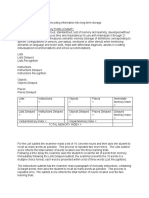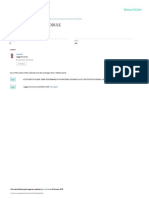Theory of Bureaucracy Bureaucratic Theory of Management: Maximilian Karl Emil Weber
Theory of Bureaucracy Bureaucratic Theory of Management: Maximilian Karl Emil Weber
Uploaded by
Jo-Dann N DarongCopyright:
Available Formats
Theory of Bureaucracy Bureaucratic Theory of Management: Maximilian Karl Emil Weber
Theory of Bureaucracy Bureaucratic Theory of Management: Maximilian Karl Emil Weber
Uploaded by
Jo-Dann N DarongOriginal Description:
Original Title
Copyright
Available Formats
Share this document
Did you find this document useful?
Is this content inappropriate?
Copyright:
Available Formats
Theory of Bureaucracy Bureaucratic Theory of Management: Maximilian Karl Emil Weber
Theory of Bureaucracy Bureaucratic Theory of Management: Maximilian Karl Emil Weber
Uploaded by
Jo-Dann N DarongCopyright:
Available Formats
ORGANIZATION DEVELOPMENT | Dr.
Roldan | Term 3 | 2018-2019
Theory of Bureaucracy/
Bureaucratic Theory of Management
Maximilian Karl Emil Weber | 1864 – 1920 (Germany)
- Father of bureaucratic management theory and
One of the founding fathers of sociology
- sociologist, philosopher, and political economist
- Schooled in Heidelberg University and taught in
University of Berlin, University of Freilburg, and
University of Munich
General Concept Behind the Theory:
There are three types of power can be found in organizations; (1) traditional power;
(2) charismatic power; and (3) legal power. He refers in his bureaucratic theory to the
latter as a bureaucracy. All aspects of a democracy are organized on the basis of rules
and laws, making the principle of established jurisdiction prevail.
General Premise of Bureaucracy:
Max Weber believed that “bureaucracy” was better than traditional structures.
Bureaucracy is the most efficient way to set up an organization, administration and
organizations. In a bureaucratic organization, everyone is treated equal and the
division of labor is clearly described for each employee.
The Bureaucracy
- is an organizational structure that is characterized by many rules, standardized
processes, procedures and requirements, number of desks, meticulous division of
labor and responsibility, clear hierarchies and professional, almost impersonal
interactions between employees”.
- is the basis for the systematic formation of any organization and is designed to ensure
efficiency and economic effectiveness.
- is an ideal model for management and its administration to bring an organization’s
power structure into focus.
- is an organizational structure was indispensable in large organizations in structurally
performing all tasks by a great number of employees.
Three Elements that Support Bureaucratic Management:
1. All regular activities within a bureaucracy can be regarded as official duties;
2. Management has the authority to impose rules; and
3. Rules can easily be respected on the basis of established methods.
Weber was convinced that organizations based on rational authority, where authority was
given to the most competent and qualified people, would be more efficient than those based
on who you knew. Weber called this type of rational organization a bureaucracy.
Researched by Jo-Dann N. Darong | 30 May 2019
ORGANIZATION DEVELOPMENT | Dr. Roldan | Term 3 | 2018-2019
WEBER IDENTIFIED SIX CHARACTERISTICS OR RULES OF A BUREAUCRACY
Characteristics Description
Managers are organized into hierarchical layers, where each layer of management is
Hierarchical responsible for its staff and overall performance. Each level controls the levels below
Management and is controlled by the level above This hierarchy reflects lines of bureaucratic
Structure communication and the degree of delegation and clearly lays out how powers and
responsibilities are divided.
Tasks are clearly defined and employees become skilled by specializing in doing one
Division of
thing. There is clear definition of authority and responsibility. Tasks are divided into
Labor
simple, routine categories on the basis of competencies and functional specializations.
Formal Employee selection and promotion are based on experience, competence, and
technical qualification demonstrated by examinations, education, or training. There is
Selection no nepotism. One of the basic principles is that employees are paid for their services
Process and that level of their salary is dependent on their position.
Management is separate from ownership, and managers are career employees.
Career Protection from arbitrary dismissal is guaranteed. Employees of a bureaucratic
Orientation organization are selected on the basis of their expertise. This helps in the deployment
of the right people in the right positions and thereby optimally utilizing human capital.
Formal Rules Rules and regulations are documented to ensure reliable and predictable behavior.
Managers must depend on formal organizational rules in employee relations. Formal
and rules and requirements are required to ensure uniformity, so that employees know
Regulations exactly what is expected of them.
Rules are applied uniformly to everyone. There is no preferential treatment or
favoritism. Regulations and clear requirements create distant and impersonal
Impersonality relationships between employees, with the additional advantage of preventing
nepotism or involvement from outsiders or politics.
Weber thought bureaucracy would result in the highest level of efficiency, rationality, and
worker satisfaction. In fact, he felt that bureaucracy was so logical that it would transform
all of society.
Unfortunately, Weber did not anticipate that each of the bureaucratic characteristics could
also have a negative result. Today, the term “bureaucracy” has taken on negative
connotations. It is associated with excessive paperwork, apathy, unresponsiveness, and
inflexibility. For example, division of labor leads to specialized and highly skilled workers,
but it also can lead to tedium and boredom. Formal rules and regulations lead to uniformity
and predictability, but they also can lead to excessive procedures and “red tape.”
MAJOR REFERENCES
- Adler PS (2009) The Oxford handbook of sociology and organization studies: Classical foundations. Oxford University Press, USA.
- Katz, D. & Kahn, R. L. (1978). The social psychology of organizations. Wiley.
- Udy Jr, S. H. (1959). Bureaucracy and Rationality in Weber’s Organization Theory: An Empirical Study. American Sociological Review, 791-795.
- Weber, M. (1978). Economy and society: An outline of interpretive sociology. University of California Press.
Researched by Jo-Dann N. Darong | 30 May 2019
You might also like
- Appendix - E.17 Study Start Social Responsiveness Scale-Preschool PDFDocument4 pagesAppendix - E.17 Study Start Social Responsiveness Scale-Preschool PDFMa Cyril Dawn Muncada50% (2)
- Template Memory ChAMPDocument2 pagesTemplate Memory ChAMPBarbaraNo ratings yet
- Jeremiah Reyes - Loob and Kapwa An Introduction To A Filipino Virtue Ethics-1Document24 pagesJeremiah Reyes - Loob and Kapwa An Introduction To A Filipino Virtue Ethics-1Enrico_Larios100% (2)
- Political Process Theories 1 PDFDocument4 pagesPolitical Process Theories 1 PDFDhong Paghubasan LepitenNo ratings yet
- The Giving of Orders: Mary Parker FollettDocument11 pagesThe Giving of Orders: Mary Parker FollettPhaura Reinz100% (2)
- Criticism On Scientific Management (Final Article)Document18 pagesCriticism On Scientific Management (Final Article)Mizanur Rahman Peash100% (1)
- Breaking Free From OCD (Book, Salkovskis & Others, 2011)Document220 pagesBreaking Free From OCD (Book, Salkovskis & Others, 2011)Luisa fernanda Avila UrueñaNo ratings yet
- Weber ModelDocument3 pagesWeber ModelJennifer VegaNo ratings yet
- Bureaucratic Theory M.P.ADocument4 pagesBureaucratic Theory M.P.AArslan MukhtarNo ratings yet
- Max Webers Theory of BureaucracyDocument20 pagesMax Webers Theory of BureaucracyJC CulisNo ratings yet
- Bureacratic OrganizationDocument11 pagesBureacratic OrganizationAnna OcampoNo ratings yet
- Weber and BureaucracyDocument5 pagesWeber and BureaucracylukeNo ratings yet
- Bureaucratic Theory of ManagementDocument2 pagesBureaucratic Theory of Managementa4birmecha100% (1)
- BureaucracyDocument52 pagesBureaucracyverles100% (1)
- Nature of Public AdministrationDocument137 pagesNature of Public AdministrationAbigail Yassin100% (1)
- Organizational Behavior SlidesDocument91 pagesOrganizational Behavior SlidesNawab AliNo ratings yet
- Power and AuthorityDocument12 pagesPower and Authorityanjna_joshi123100% (1)
- Attitude PDFDocument10 pagesAttitude PDFDaksh AnejaNo ratings yet
- Theories of OrganizationsDocument21 pagesTheories of Organizations1921 Pallav Pali100% (2)
- Management TheoryDocument9 pagesManagement TheoryHarsh BallavNo ratings yet
- Nature and Scope of Public AdministrationDocument3 pagesNature and Scope of Public AdministrationDodong LamelaNo ratings yet
- Mcgregor'S Theory X and Theory YDocument11 pagesMcgregor'S Theory X and Theory YMuhammad MurtazaNo ratings yet
- Criticism For Max WeberDocument18 pagesCriticism For Max WeberAisha KhanNo ratings yet
- Public Ad (Lecture 18) Major Schools of Thought in AdministrationDocument23 pagesPublic Ad (Lecture 18) Major Schools of Thought in AdministrationHafiz Farrukh Ishaq IshaqNo ratings yet
- Administrative Theory of ManagementDocument6 pagesAdministrative Theory of ManagementNauman MalikNo ratings yet
- BureaucracyDocument28 pagesBureaucracyProf. Mohammed Abdul Wahab AlAzzawi100% (25)
- Eva Week 3 Comparison Fayol WeberDocument5 pagesEva Week 3 Comparison Fayol WeberRizky Muhammad100% (4)
- Bureaucracy DefinedDocument5 pagesBureaucracy DefinedKent Alvin GuzmanNo ratings yet
- Chapter 12-Leadership HandoutDocument10 pagesChapter 12-Leadership HandoutAdil KiromNo ratings yet
- Systems Theory of Management # 2Document22 pagesSystems Theory of Management # 2Judy Ann FunitNo ratings yet
- Bureaucratic Theory Max WeberDocument3 pagesBureaucratic Theory Max WeberDeepak SharmaNo ratings yet
- Theories of Management Assignment 1Document14 pagesTheories of Management Assignment 1papabaksNo ratings yet
- PubadDocument19 pagesPubadअपूर्व उत्सव झाNo ratings yet
- Organisational CultureDocument10 pagesOrganisational CultureRAKESH SHARMA100% (1)
- New Public ManagementDocument15 pagesNew Public ManagementICS Assam100% (1)
- Van Wart 2003 Public Sector LeadershipDocument15 pagesVan Wart 2003 Public Sector LeadershipRizalNo ratings yet
- Classical TheoryDocument5 pagesClassical Theoryraj_sahu1823100% (2)
- Introduction To Organizational BehaviourDocument2 pagesIntroduction To Organizational BehaviourDumitru ErhanNo ratings yet
- The Classical Theory of Organization and Its Relevance - IRJFE - 41 - 06Document8 pagesThe Classical Theory of Organization and Its Relevance - IRJFE - 41 - 06coxshulerNo ratings yet
- Unitary TheoryDocument5 pagesUnitary TheorySuhag100% (1)
- Organisational StructureDocument41 pagesOrganisational StructureRahul Basnet0% (1)
- Organization Behavior: Human Behavior at WorkDocument34 pagesOrganization Behavior: Human Behavior at Workdcs019No ratings yet
- Behavioral Approach of ManagementDocument2 pagesBehavioral Approach of ManagementVAIBHAV JAINNo ratings yet
- Modern Approaches To ManagementDocument22 pagesModern Approaches To ManagementRunaway Shuji100% (1)
- Public Administration at Whole PDFDocument4 pagesPublic Administration at Whole PDFKashaf RimshaNo ratings yet
- PAD 190 BureaucracyDocument20 pagesPAD 190 Bureaucracynsaid_31No ratings yet
- POSDCORB: Core Patterns of Administration: Recognition) : Design Methodology-Pattern AnalysisDocument20 pagesPOSDCORB: Core Patterns of Administration: Recognition) : Design Methodology-Pattern AnalysisJofil LomboyNo ratings yet
- 14 Principles of ManagementDocument6 pages14 Principles of ManagementTehseen1993No ratings yet
- Administrative Management Theory of Henry Fayol, Luther Gulick, and Lydall UrwickDocument1 pageAdministrative Management Theory of Henry Fayol, Luther Gulick, and Lydall Urwickmeldgyrie mae andalesNo ratings yet
- The Enterprise of Public AdministrationDocument7 pagesThe Enterprise of Public AdministrationArni Estacio0% (1)
- Module 1 Academic - ScriptDocument10 pagesModule 1 Academic - ScriptArya TrivediNo ratings yet
- PAD204 AssignmentDocument11 pagesPAD204 AssignmentCorneynie Reynd GunsinNo ratings yet
- An Analysis of The Transformational Leadership Theory: Journal of Fundamental and Applied Sciences August 2016Document13 pagesAn Analysis of The Transformational Leadership Theory: Journal of Fundamental and Applied Sciences August 2016Pragash MsbNo ratings yet
- The Key Characteristics of A BureaucracyDocument3 pagesThe Key Characteristics of A Bureaucracyyuix100% (2)
- Meaning and Definition of Public Administration PDFDocument3 pagesMeaning and Definition of Public Administration PDFPratima MukherjeeNo ratings yet
- The Search For Organizational IntegrationDocument15 pagesThe Search For Organizational IntegrationReza Zulakhfi100% (1)
- Introduction To Public Administration AB PDFDocument17 pagesIntroduction To Public Administration AB PDFDarpan AdvertismentNo ratings yet
- Power and Politics in Organization Final ProjectDocument29 pagesPower and Politics in Organization Final ProjectShubhankar Rudra100% (1)
- Public Administration's Final Exam: A Pragmatist Restructuring of the Profession and the DisciplineFrom EverandPublic Administration's Final Exam: A Pragmatist Restructuring of the Profession and the DisciplineNo ratings yet
- Transformational and Transactional Leadership in Mental Health and Substance Abuse OrganizationsFrom EverandTransformational and Transactional Leadership in Mental Health and Substance Abuse OrganizationsNo ratings yet
- MPP Project WorkDocument11 pagesMPP Project WorkSayeed RahmatullahNo ratings yet
- Mini Research - Esp Course Design - Group DDocument33 pagesMini Research - Esp Course Design - Group DPutri IlsaNo ratings yet
- AusubelDocument65 pagesAusubelRavin Ravi100% (2)
- Chapter IIIDocument11 pagesChapter IIIAbdul R. SidikNo ratings yet
- Lecture 9 Buying and DisposingDocument32 pagesLecture 9 Buying and Disposingzaid mustafaNo ratings yet
- JUNE22-26 IWAR-Teaching-JOCELYN-wk4Document2 pagesJUNE22-26 IWAR-Teaching-JOCELYN-wk4Jho Dacion RoxasNo ratings yet
- John Searle The Phenomenological IllusionDocument15 pagesJohn Searle The Phenomenological IllusionDick Tracy TracyNo ratings yet
- Mnemonic Similarity Task: A Tool For Assessing Hippocampal IntegrityDocument14 pagesMnemonic Similarity Task: A Tool For Assessing Hippocampal IntegrityEszter SzerencsiNo ratings yet
- Module 1 - Week 1: Motivational and Affective Factors (3 Principles) Cognitive and Metacognitive Factor (6 Principles)Document6 pagesModule 1 - Week 1: Motivational and Affective Factors (3 Principles) Cognitive and Metacognitive Factor (6 Principles)Noel Jr MospaNo ratings yet
- Lesson Plan in Integrated ScienceDocument3 pagesLesson Plan in Integrated ScienceOcariza Christy100% (2)
- Leadership Style QuestionnaireDocument2 pagesLeadership Style QuestionnaireDivyam SinghNo ratings yet
- pr2 1Document30 pagespr2 1Julius Arthur Reformina OlacoNo ratings yet
- The Psychology of InceldomDocument41 pagesThe Psychology of InceldomCARLOSFERNANDESNo ratings yet
- Perdev 3 and 4Document7 pagesPerdev 3 and 4Lloyd ManubagNo ratings yet
- Annotated BibliographyDocument6 pagesAnnotated BibliographyErin GleasonNo ratings yet
- CaseDocument4 pagesCaseelixNo ratings yet
- Module 8 Leson 1,2&3Document11 pagesModule 8 Leson 1,2&3rhea crystal regenciaNo ratings yet
- Easing The Transition From Students To NursesDocument22 pagesEasing The Transition From Students To Nursesjohn michael olivares67% (3)
- PR1 DLP2Document2 pagesPR1 DLP2Ferdinand VillanuevaNo ratings yet
- En-3 0-Main MDDocument34 pagesEn-3 0-Main MDCameron BernalNo ratings yet
- Nursing Care Plan ADocument6 pagesNursing Care Plan ACrystal WyattNo ratings yet
- Edu 290 Diversity PaperDocument10 pagesEdu 290 Diversity Paperapi-531486255No ratings yet
- Lesson 1 Listening Teaching English in The Elementary Grade Language ArtsDocument22 pagesLesson 1 Listening Teaching English in The Elementary Grade Language ArtsKristel RicaldeNo ratings yet
- Intelligence Versus Happiness in Flowers For Algernon by Daniel KeyesDocument4 pagesIntelligence Versus Happiness in Flowers For Algernon by Daniel KeyesFaheem MoeNo ratings yet
- Non Experimental DesignDocument52 pagesNon Experimental DesignAmal B Chandran100% (1)
- Bettenhausen 1991 - Five Years of Group Research - What We Have Learned and What Needs To Be AddressedDocument37 pagesBettenhausen 1991 - Five Years of Group Research - What We Have Learned and What Needs To Be AddressedBarry HemmingsNo ratings yet
- Uswa New Project 8613Document20 pagesUswa New Project 8613anaskhuram3No ratings yet

























































































